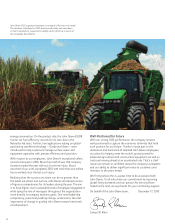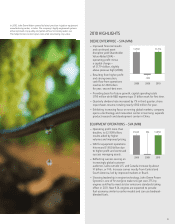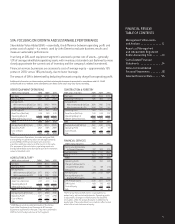John Deere 2010 Annual Report Download - page 18
Download and view the complete annual report
Please find page 18 of the 2010 John Deere annual report below. You can navigate through the pages in the report by either clicking on the pages listed below, or by using the keyword search tool below to find specific information within the annual report.
18
Debt Ratings. To access public debt capital markets, the
company relies on credit rating agencies to assign short-term
and long-term credit ratings to the company’s securities as an
indicator of credit quality for fi xed income investors. A security
rating is not a recommendation by the rating agency to buy,
sell or hold company securities. A credit rating agency may
change or withdraw company ratings based on its assessment
of the company’s current and future ability to meet interest and
principal repayment obligations. Each agency’s rating should
be evaluated independently of any other rating. Lower credit
ratings generally result in higher borrowing costs and reduced
access to debt capital markets. Credit ratings also affect the costs
of derivative transactions, including interest rate and foreign
currency derivative transactions. As a result, negative changes
in the company’s credit ratings could adversely impact the
company’s cost of funding. The senior long-term and short-
term debt ratings and outlook currently assigned to unsecured
company securities by the rating agencies engaged by the
company are as follows:
Senior
Long-Term Short-Term Outlook
Moody’s Investors
S ervice, Inc. ......................... A 2 Pr ime-1 St able
Standard & Poor’s .................. A A-1 Stable
Trade accounts and notes receivable primarily arise
from sales of goods to independent dealers. Trade receivables
increased by $847 million in 2010, primarily due to higher
production and shipment volumes. The ratio of trade accounts
and notes receivable at October 31 to fi scal year net sales was
15 percent in 2010 and 13 percent in 2009. Total worldwide
agriculture and turf receivables increased $566 million and
construction and forestry receivables increased $281 million.
The collection period for trade receivables averages less than
12 months. The percentage of trade receivables outstanding for
a period exceeding 12 months was 3 percent and 4 percent at
October 31, 2010 and 2009, respectively.
Deere & Company’s stockholders’ equity was $6,290
million at October 31, 2010, compared with $4,819 million
at October 31, 2009. The increase of $1,471 million resulted
primarily from net income attributable to Deere & Company
of $1,865 million, a change in the retirement benefi ts adjustment
of $158 million, an increase in common stock of $110 million
and a change in the cumulative translation adjustment of
$36 million, which were partially offset by dividends declared of
$492 million and an increase in treasury stock of $225 million.
EQUIPMENT OPERATIONS
The company’s equipment businesses are capital intensive and
are subject to seasonal variations in fi nancing requirements for
inventories and certain receivables from dealers. The Equipment
Operations sell a signifi cant portion of their trade receivables
to Financial Services. To the extent necessary, funds provided
from operations are supplemented by external fi nancing sources.
Cash provided by operating activities of the Equipment
Operations during 2010, including intercompany cash fl ows,
was $2,545 million primarily due to net income adjusted for
non-cash provisions and an increase in accounts payable and
accrued expenses, partially offset by an increase in inventories
and trade receivables.
Over the last three years, these operating activities,
including intercompany cash fl ows, have provided an aggregate
of $6,335 million in cash.
Trade receivables held by the Equipment Operations
increased by $224 million during 2010. The Equipment
Operations sell a signifi cant portion of their trade receivables
to Financial Services (see previous consolidated discussion).
Inventories increased by $666 million in 2010 primarily
refl ecting the increase in production and sales. Most of these
inventories are valued on the last-in, fi rst-out (LIFO) method.
The ratios of inventories on a fi rst-in, fi rst-out (FIFO) basis
(see Note 15), which approximates current cost, to fi scal year
cost of sales were 26 percent and 23 percent at October 31, 2010
and 2009, respectively.
Total interest-bearing debt of the Equipment Operations
was $3,414 million at the end of 2010, compared with $3,563
million at the end of 2009 and $2,209 million at the end of 2008.
The ratio of total debt to total capital (total interest-bearing
debt and stockholders’ equity) at the end of 2010, 2009 and
2008 was 35 percent, 43 percent and 25 percent, respectively.
Property and equipment cash expenditures for the
Equipment Operations in 2010 were $736 million, compared
with $788 million in 2009. Capital expenditures in 2011 are
estimated to be approximately $1,000 million.
FINANCIAL SERVICES
The Financial Services’ credit operations rely on their ability to
raise substantial amounts of funds to fi nance their receivable and
lease portfolios. Their primary sources of funds for this purpose
are a combination of commercial paper, term debt, securitization
of retail notes, equity capital and from time to time borrowings
from Deere & Company.
The cash provided by operating activities, fi nancing
activities and the beginning balance of cash and cash equivalents
was used for investing activities. Cash fl ows from the Financial
Services’ operating activities, including intercompany cash fl ows,
were $1,274 million in 2010. Cash used by investing activities
totaled $2,658 million in 2010, primarily due to the cost of
receivables and equipment on operating leases exceeding
collections of receivables and the proceeds from sales of
equipment on operating leases by $2,709 million. Cash provided
by fi nancing activities totaled $872 million in 2010, representing
primarily an increase in borrowings from Deere & Company
of $1,230 million, partially offset by a $164 million decrease
in external borrowings. Cash and cash equivalents decreased
$520 million.
Over the last three years, the Financial Services’
operating activities, including intercompany cash fl ows, have
provided $3,111 million in cash. In addition, an increase in
total borrowings of $2,159 million and capital investment from
Deere & Company of $599 million provided cash infl ows.
These amounts have been used mainly to fund receivable and
equipment on operating lease acquisitions, which exceeded
collections and the proceeds from sales of equipment on operating
leases by $4,490 million, pay dividends to Deere & Company
























